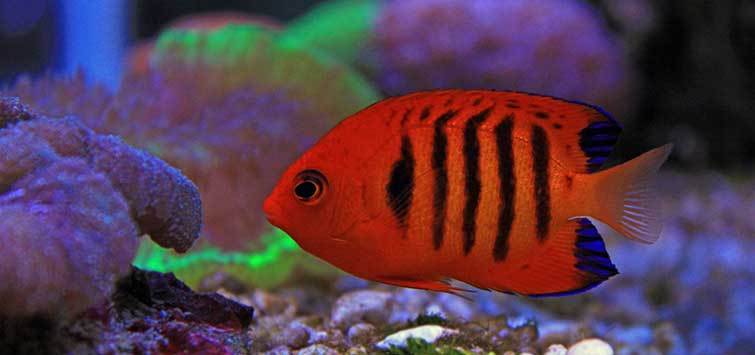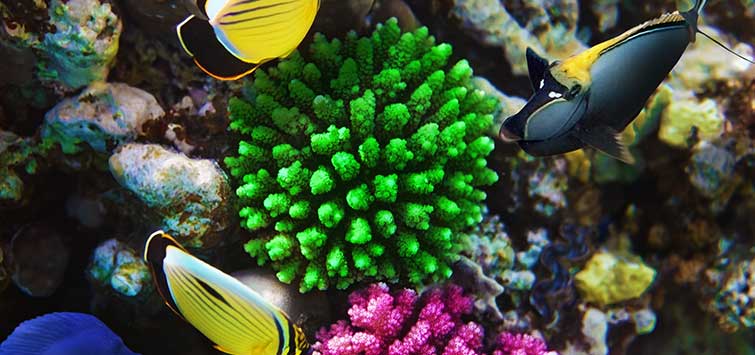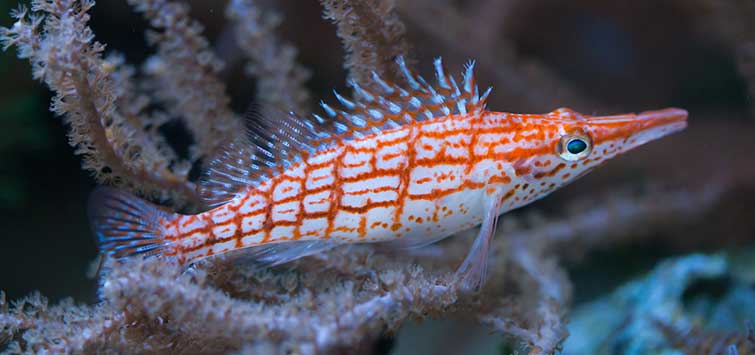Centropyge loricula
Common Names: Flame angel
Type Locality: Society Islands
Range: Throughout the central Pacific Ocean
Taxonomic Troubles: Originally described as Holacanthus loriculus; sometimes misnames Centropyge loriculus; loricula is correct.
Size: To 15 cm (6 inches), usually smaller.
Preferred Water Chemistry: Marine, tropical. Temperature 24 to 28 degrees Celsius (75 to 82 degrees Fahrenheit), SG 1.025, pH 8.3
Difficulty: An easy marine if healthy to begin with.
Tank Setup: Best kept in a mature live rock system. Aggressive and territorial with conspecifics. Males will fight to the death. Can often be maintained in pairs or harems. Provide numerous hiding places--live rock piles are ideal.
Feeding: Primarily an algae eater. Must have marine algae or algae-based foods as the bulk of the diet. Mature live rock also provides small invertebrates. This species may pick on coral polyps and other sessile invertebrates.
Breeding: Spawnings are quite common. Until recently, raising the young has been difficult at best, but commercially available tank-bred specimens are now on the market.
Fish Description
Bright orange-red to deep red, depending on the population , with a variable blue-black blotch behind the pectorals and (in most specimens) four or five vertical bars. The tips of the dorsal and anal fins have alternating blue and black stripes.
Notes
The flame angel has long been a favorite among saltwater hobbyists. As with many marine species, there is considerable variation in survivability based on the source of this fish. Once established and provided with an algae-based diet, this is one of the hardiest marine aquarium species. Its beauty only adds to its appeal, and now the availability of captive-bred animals makes this species a better choice than ever.
As with most dwarf angels, aggression can be a problem. Since these fish are protogynous hermaphrodites, buying the largest and the smallest fish you can find often will yield a pair. Or, obtaining a group of three or four young juveniles should get you a single-male harem. It is a timid species and needs a lot of tiny caves into which it can flee. It also does best when provided with a mature system with plenty of algae and healthy micro crustacean populations. Thus, a reef tank is a good environment for these fish; the question is whether they are good for a reef tank.
Although many reefers maintain this species in their tanks, its reputation is extremely variable, and many other hobbyists label it totally unsafe. The safest choice would be FOLR (fish-only-live-rock) setup. The Centropyge dwarf or pygmy angels enable aquarists to have the graceful stateliness of a marine angel without the problemns associated with many of the larger pomacanthids--extreme size, extreme territoriality, and extreme dietary requirements that are near impossible to meet. Among the dwarfs, the flame angel is deservedly one of the most popular.

.png?h=595&iar=0&w=2781&hash=5FD5E69473BCC22199FBFA2FB71B6033)



